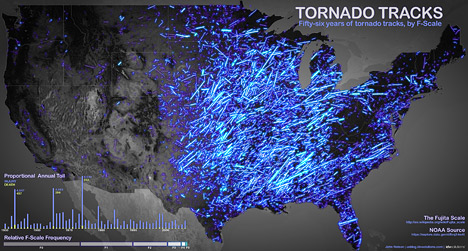Tornadoes plague the central and eastern sections of the contiguous United States far more than the western portion. That much is obvious from this map showing 56 years of tornado tracks, from 1950 through 2006.

This map breaks down tornadoes by strength based on the Fujita scale. Stronger tornadoes appear as brighter lines. (An enhanced Fujita scale was implemented in 2007, but these tornado tracks were classified according to the earlier version.)
One prerequisite for tornado formation is humidity, which is much greater in the east than in the west. But topography also plays a role; few tornadoes form over mountainous West Virginia, for instance.
This map was created by John Nelson of IDV Solutions. He obtained the data through Data.gov, which was set up to “increase public access to high value, machine readable datasets” generated by the U.S. government. A high-resolution version of this image is available here.




Why does is general direction of the tornado tracks tend toward the NE? It looks like there may be some counterclockwise motion. Is that due to the Coriolis effect in the Northern Hemisphere?
Correction to my previous comment – the motion is clockwise. My guess about the Coriolis effect still stands.
The graphic would support the development of tornados in warm, moist air ahead of eastward moving thunderstorms. The air coming in from the Pacific should be too cool, air over the southwest – too dry. The moist, warm air swept in from the Gulf of Mexico and Mississippi Valley fed into the storms developing across the middle of the country – just right.
Here is a companion visual that segregates this data out by seasonality (and uses newer data, up through 2011). Rick Varner’s comment above describes it well:
http://uxblog.idvsolutions.com/2012/06/seasonal-tornado-habitats-1950-2011.html
We’ve recently provided an interactive version of this map, where you can zoom and pan and filter by time, category, impact, etc.
http://uxblog.idvsolutions.com/2012/07/interactive-tornado-tracks-map-is-live.html
The “debt” we owe the animals, plants, fungi and microbes that occupy the species forest, species grasslands, species islands and species sea is . . . enormous. The best way to pay back all the other species is to give them back their land as I have done. All the private land in the US is owned by someone and usually someone else inherits form them. End the cycle and simply donate it back to the species forest. You will not miss it. Well, maybe the cash.